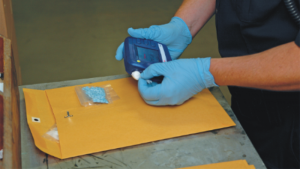The 2017 Dodge Charger Pursuit law enforcement vehicle will have technology that detects movement behind the vehicle through the use of its rear-facing camera and radar. The new technology is designed to help police avoid a dangerous ambush situation while in their vehicles.
In 2016, more than 130 police officers were killed in the line of duty in the United States, which is the highest number of fatalities on the job in five years. Every day police officers around the country put themselves in harm’s way; luckily new advancements in technology are helping to reduce deaths and injuries among police.
The Bartholomew County Sheriff’s Department in Indiana received permission to purchase a TruNarc Handheld Narcotics Analyzer. The device is able to test for 370 illicit substances without requiring police to open any packaging that may be around the suspected substance.
The Glendale Police Department in California is partnering with Project Lifesaver to help reunite missing individuals with their loved ones by using wearable tracking devices.
About 1 million people are expected to flock to Houston for 10 days of Super Bowl-related activities and more than 100 million people are expected to watch the Feb. 5 game on television. Officials have been working for more than a year to perfect a surveillance-based approach, more sophisticated than in past years, that includes surveillance cameras, overhead helicopters, and Houston police.
Over the past few years, police departments have moved away from traditional surveying instruments and have adopted 3-D scanners to re-create places where homicides, car accidents, and sexual assaults occurred.
Disability Rights New York filed a Federal complaint last week calling for New York City to upgrade its emergency services technology to accept text-to-911.
After the deadliest year in more than 20 years, the Chicago Police Department released its 2017 initiatives to reduce violence. The initiative relies heavily on using technology, specifically data analytics, to better understand how law enforcement can best protect residents and visitors.
With a rise in public mistrust of police forces in cities across the country, many police departments have been refocusing their efforts on community policing to re-establish public trust.
A group of policy-makers, health care providers, and first responders recommended that the state of Nevada create a data center with information on opioid prescriptions.












